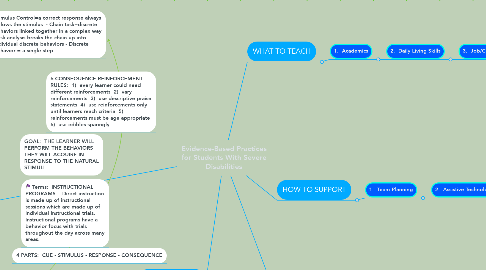Evidence-Based Practices for Students With Severe Disabilities
by Marcia Graetz


1. 6 CONSEQUENCE REINFORCEMENT RULES: 1) every learner could need different reinforcements 2) vary reinforcements 3) use descriptive praise statements 4) use reinforcements only until learners reach criteria 5) reinforcements must be age appropriate 6) use edibles sparingly
2. GOAL: THE LEARNER WILL PERFORM THE BEHAVIORS THEY WILL ACQUIRE IN RESPONSE TO THE NATURAL STIMULI
3. Stimulus Control=a correct response always follows the stimulus - Chain task=discrete behaviors linked together in a complex way (task analysis breaks the chain up into individual discrete behaviors - Discrete behavior = a single step
3.1. FORWARD CHAINING = one step taught at a time
3.2. BACKWARD CHAINING = model all but last step and work backward
3.3. TOTAL TASK PRESENTATION = demonstrate all then work on steps needed
4. 4 PARTS: CUE - STIMULUS - RESPONSE - CONSEQUENCE
5. Terms: INSTRUCTIONAL PROGRAMS - Direct instruction is made up of instructional sessions which are made up of individual instructional trials. Instructional programs have a behavior focus with trials throughout the day across many areas.
6. HOW TO TEACH
6.1. 1. Using Systematic Instruction
6.1.1. 2. Self-Directed Learning
6.1.1.1. 3. Peer Tutors
6.1.1.1.1. 4. Technology
7. IMPORTANT TERMS
7.1. Def. of Developmental Disability - before age 22, chronic & severe, attributed to a mental, physical, or combination of both impairment, results in substantial functional limitations in major life activities, and has a life-long need for special services.
8. 5 BEST PRACTICES
8.1. 1. Inclusive environment
8.2. 2. Home-school colaboration
8.3. 3. Data-based instruction
8.4. 4. Functional preporation
9. WHAT TO TEACH
9.1. 1. Academics
9.1.1. 2. Daily Living Skills
9.1.1.1. 3. Job/Community Skills
9.1.1.1.1. 4. Self-Determination Skills
10. HOW TO SUPPORT
10.1. 1. Team Planning
10.1.1. 2. Assistive Technology
10.1.1.1. 3. Per Supports
10.1.1.1.1. 4. Inclusive Settings

